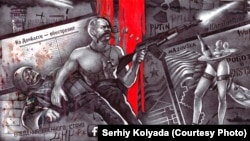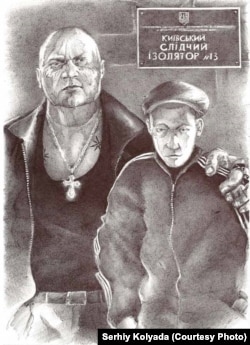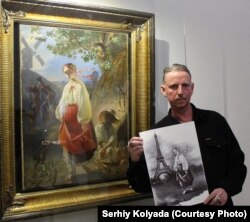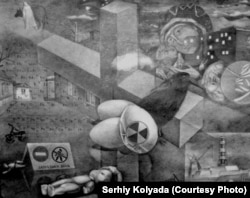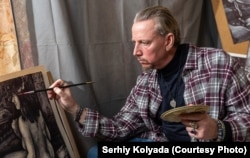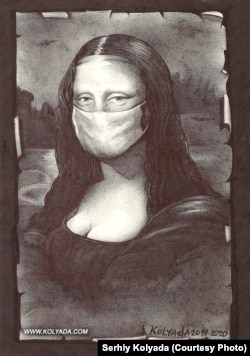KYIV -- Whatever his subject -- a tycoon living large while many go hungry, a goon hired to break up protests, an impoverished Ukrainian driven abroad to seek work -- artist Serhiy Kolyada puts it down on paper with a simple tool: a ballpoint pen.
A 49-year-old whose life and art span the late Soviet era and the three often tumultuous decades that have followed since independence in 1991, Kolyada draws inspiration from "everywhere" -- and then, putting the tip of a Bic to plain construction paper, draws images he says depict Ukraine's underbelly.
They portray the ills of society, the depredations of the state, and the aspects of life that hurt Ukraine's image abroad, such as greed, corruption, sex tourism, poverty-associated labor migration, alcoholism, and, as he sees it, criminals in parliament.
He calls it "zhlob" art. The term is tough to translate deftly, with meanings ranging from 'parasite' to a rude, narrow-minded goon. But Kolyada's works are full of such "anti-heroes," whether it's a venal oligarch or a thug the oligarch uses as paid muscle to execute the forcible takeover of a company.
"It's a person who is uncouth and behaves belligerently in society," he said. "Like they don't pick up trash after themselves…in the criminal world they roll drunks for money…and later these people enter politics and while in power they foster corruption by continuing the practice of stealing" from the state budget.
It's a societal symptom that "starts from the bottom and goes all the way to the top," Kolyada added.
Kolyada's works can be off-putting, and that may be his aim: Speaking to RFE/RL in his makeshift home studio in Kyiv, he said that his target is the viewer's brain, not their eyes.
"We already have a lot of art that performs a decorative function, that is pleasing to the eye…. What we need is art that will make a person think," Kolyada said.
Over time, an ominous figure in a series of his drawings has become Kateryna, a barefoot, frowning woman from an 1842 painting by Taras Shevchenko, a multitalented poet and artist who is a towering figure in Ukrainian culture, which depicts her parting ways with a tsarist Russian officer.
He has inserted an identical image of her in numerous settings such as Capitol Hill in Washington, Moscow's Red Square, and in Kyiv on the barricades of the Maidan – the massive protests that were ignited in part by anger over corruption and pushed Moscow-friendly President Viktor Yanukovych from power in 2014.
Through Kateryna, Kolyada said, he tries "to show what Ukraine is and means…in the former Soviet Union, we were all Russians…here I want to show that we are a distinct country."
By placing her in various foreign settings, the artist said he is highlighting the "plight of Ukrainian women who have had to go abroad to make money as labor migrants."
He chose her, he said, "because nothing has changed in the 200-odd years since Shevchenko's lifetime."
The "government still has the same attitude toward its people…the same social problems exist. We still have a feudal system with barons," Kolyada said, referring to tycoons widely seen as wielding political influence.
President Volodymyr Zelenskiy was democratically elected but behaves like a "monarch" and "has oligarchs for princes," he said, without providing details to back up his remarks.
Kolyada also turns to other figures from the past, from Kyiv-born Soviet-era writer Mikhail Bulgakov back to the Bible and much in between. He has mixed elements of pop culture with images from the Renaissance -- Michelangelo's David on a nude beach – and the works of Nikolai Gogol, another major figure in Ukraine.
Since the Maidan – after which Russia seized the Crimean Peninsula and backed anti-Kyiv forces in a war that still continues in eastern Ukraine -- Kolyada has added scenes from the protest movement to his drawings "to show there are people ready to sacrifice their lives for freedom, their country, and to protect their fellow countrymen."
'In My Dreams'
Kolyada's disaffection with state and society is firmly rooted in the Soviet era, which ended when he was about 20 years old.
He attributes his acute sense of justice from listening to broadcasts of the Voice of America (VOA), RFE/RL, and the BBC on a shortwave radio.
As it was for many people in Ukraine and elsewhere, the 1986 disaster at the Chernobyl nuclear power plant was the origin of his distrust toward the Soviet system, Kolyada said. He began to listen to the Western broadcasters in the evening and write letters to the editors.
"I think this is when the KGB started homing in on me, especially when a priest who ran a program on VOA wrote me back and the envelope had been opened," he said.
As he grew older, Kolyada started taking part in anti-government protests and drawing images that skewered the Soviet authorities and pointed up the empty shop shelves, as well as taking art classes.
Later, his application to an art institute in Kharkiv was rejected. He spent a month in Sweden around the time of the abortive August 1991 coup that accelerated the Soviet breakup. He was denied political asylum and was met by KGB officers when he flew to Moscow.
He then returned to the university in Zaporizhzhya where he had been enrolled, but was soon kicked out for his "anti-Soviet stance" and ended up completing training to be a Ukrainian-language teacher at a university in Berdyansk, the Azov Sea port city where he grew up after being born in Odesa.
Eventually graduating in 1997, Kolyada headed for Kyiv and continued drawing with a ballpoint pen, living in part off the money he had made selling his sketches during his university days.
Kolyada draws his inspiration from "everywhere," he said -- on the street, in the news, in books and advertisements, and "in my dreams." When an idea for an artwork germinates, it "takes a long a long time for the subject to come to a boil in my brain."
Once they're on paper, his works can fetch up to $3,000, depending in part on the size, but on average they sell for $500 to $600. That's a far cry from what can be earned by more famous Ukrainian artists: A work by Lviv-based painter Ivan Turetskiy sold $21,250 at an April auction at Sotheby's in New York.
Galleries and the art establishment in Ukraine have mostly shunned his works, which often feature eroticism and nudity along with their in-your-face imagery.
"Gallery owners 'like' my works on Facebook but never offer to exhibit them," he said. "It's a confusing situation and they don't provide a specific reason."
He said gallery owners have offered to show his work but have demanded that he put up $1,000 yet still allow them to choose which pieces to display.
"It's a closed circle," he said, adding that he supplements his income working as a computer graphics artist and shrugging off the slights. "I don't pay attention to them [gallerists]…they ignore me and I ignore them."
Kolyada has had more success abroad and with expatriates in Ukraine.
Occasionally, Kolyada adds gouache or watercolors to his ballpoint-pen work, such as in a drawing he devoted to the September 11, 2001, terrorist attacks in the United States. When it comes to materials, he says he has tried "all of them."
"I've drawn with a pencil, painted with watercolors and oil -- but I've always returned to my ink," he said.
It's not a crowded field. Kolyada said he is the only prominent Ukrainian member of the informal ballpoint pen art movement.
"There used to be another ballpointer, in Luhansk," he said, referring to one of the eastern cities held by Russia-backed separatists. "But when the war with Russia started in 2014, I lost track of him, and I don't know where he is now."




